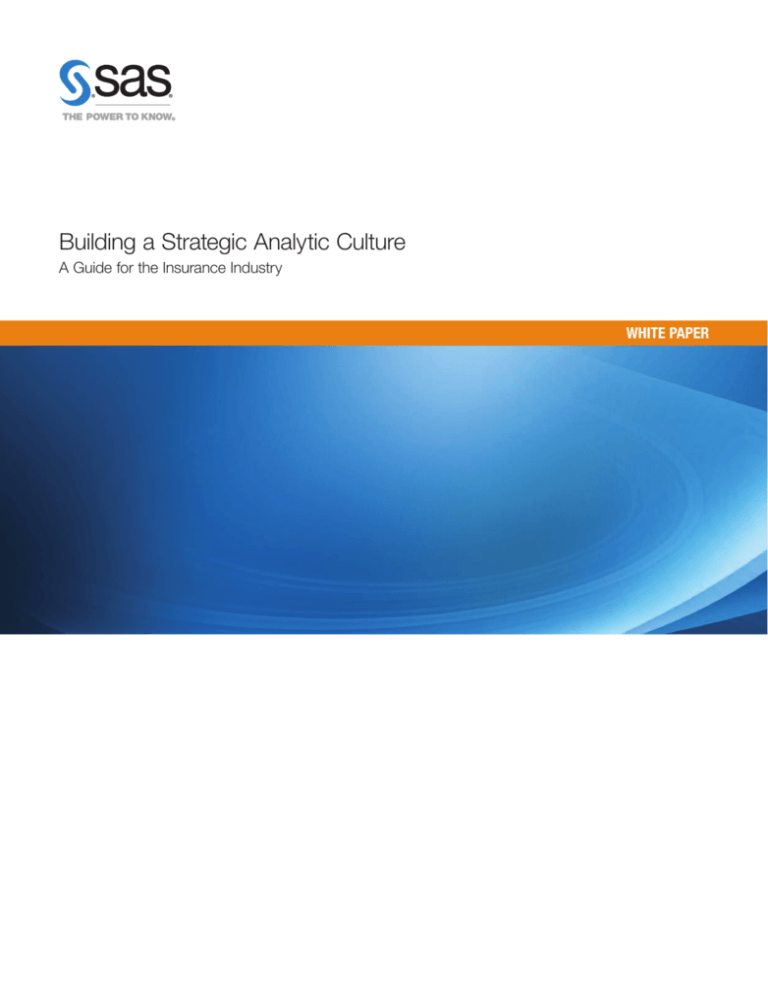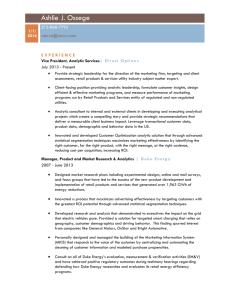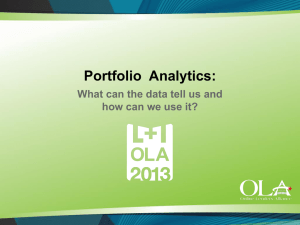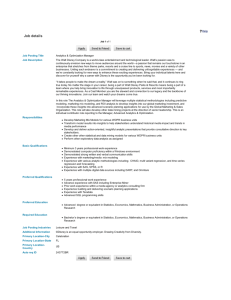
Building a Strategic Analytic Culture
A Guide for the Insurance Industry
WHITE PAPER
SAS White Paper
Table of Contents
Introduction. . . . . . . . . . . . . . . . . . . . . . . . . . . . . . . . . . . . . . . . . . . . . . . 1
Anatomy of a Strategic Analytic Culture. . . . . . . . . . . . . . . . . . . . . . . . 2
Executive Commitment. . . . . . . . . . . . . . . . . . . . . . . . . . . . . . . . . . . . . 2
Use Analytics to Set Business Strategies . . . . . . . . . . . . . . . . . . . . . . . 3
Commitment to Data Management. . . . . . . . . . . . . . . . . . . . . . . . . . . . 3
Enterprise Use of Analytics . . . . . . . . . . . . . . . . . . . . . . . . . . . . . . . . . . 3
Culture of Fact-Based Decision Making . . . . . . . . . . . . . . . . . . . . . . . . 4
Focus Areas for a Strategic Analytic Culture . . . . . . . . . . . . . . . . . . . . 4
Focus Area 1: Business Analytics Skills and Resources. . . . . . . . . . . . 5
Provide the right balance of resources. . . . . . . . . . . . . . . . . . . . . . . . . . . . . . . . 5
Make analytics more approachable . . . . . . . . . . . . . . . . . . . . . . . . . . . . . . . . . . 5
Focus Area 2: Information Environment and Infrastructure. . . . . . . . . . 6
Upgrade your information architecture . . . . . . . . . . . . . . . . . . . . . . . . . . . . . . . 7
Bridge the gap between IT and the business units . . . . . . . . . . . . . . . . . . . . . . 7
Capitalize on advanced analytics, not reporting . . . . . . . . . . . . . . . . . . . . . . . . . 7
Focus Area 3: Internal Processes . . . . . . . . . . . . . . . . . . . . . . . . . . . . . 8
Manage analytics as an ongoing process, not a one-off project . . . . . . . . . . . . 8
Facilitate collaboration . . . . . . . . . . . . . . . . . . . . . . . . . . . . . . . . . . . . . . . . . . . . 9
Getting Started . . . . . . . . . . . . . . . . . . . . . . . . . . . . . . . . . . . . . . . . . . . . 9
It’s a Marathon, Not a Sprint. . . . . . . . . . . . . . . . . . . . . . . . . . . . . . . . . 10
Closing Thoughts . . . . . . . . . . . . . . . . . . . . . . . . . . . . . . . . . . . . . . . . . 11
For More Information . . . . . . . . . . . . . . . . . . . . . . . . . . . . . . . . . . . . . . 11
Content provided by
Kelly A. McGuire, PhD
Executive Director, Hospitality and Travel Global Practice at SAS
and
Stuart Rose
Global Insurance Marketing Principal at SAS
Building a Strategic Analytic Culture
Introduction
The insurance marketplace is tough. It’s fiercely competitive with consumers shopping
around for the lowest premiums possible and little differentiation among products.
Insurance executives struggle to find the right balance between improving profitability
and providing competitive pricing and an unmatched customer experience. Activities
that focus on the customer experience – like claims concierge services and enhanced
agent support – can run counter to goals like lowering loss-adjustment expenses,
reducing labor costs and decreasing combined ratios.
To thrive in the new economy,
you need to build a strategic
analytic culture where analysis
is part of the corporate DNA.
The key to achieving this balance is an enterprisewide commitment to data and
analytics. Such a commitment will enable you to:
• See problems coming and take steps to prevent them instead of being reactive
and constantly fighting fires.
• Foster a culture of fact-based decision making through all levels of the
organization.
• Deliver trusted information into the hands of decision makers in time for them to
take action.
• Build a strategic analytic culture where analysis is part of your corporate DNA.
These goals, though lofty, are achievable – and necessary for organizations seeking to
survive and thrive in today’s economy. In this paper, we’ll talk about how you can build a
strategic analytic culture in your organization.
1
SAS White Paper
Anatomy of a Strategic Analytic Culture
What does a strategic analytic culture look like? Figure 1 illustrates the interrelated
components of such a culture.
Executive
management
commitment
Culture of
fact-based decision
making
Enterprise use
of analytics
Uses analytics
to set business
strategies
Commitment
to information
management
Figure 1: Anatomy of a strategic analytic culture.
Executive Commitment
A strategic analytic culture starts and ends with executive management commitment.
When executives are fully bought in to the concept of an analytic culture, they set goals,
priorities and expectations based on the use of analytics. They invest in technology,
people and processes that will continue to foster this culture. Most importantly, they
become highly sought after, both internally and externally, as their companies continue
to outpace the competition.
2
Building a Strategic Analytic Culture
Use Analytics to Set Business Strategies
Companies with a strategic analytic culture set their business strategies based on what
the analytics tell them. AIG is a great example of this. Through its Strategic Risk Analysis
group, a team responsible for continually optimizing business performance through
analytics, the company has implemented 16 underwriting and finance predictive models
that have helped prevent millions of dollars in potential losses. One example involved
assessing executive liability insurance. Using SAS® Analytics, the Strategic Risk Analysis
group found six potentially significant predictors and developed its own quantitative
risk model (QRM) to enable risk-based business decisions. Using this model over an
18-month period, AIG was able to target $14 million in new business, representing
100 percent growth. In addition, the modeling tool helped prevent potential losses of
$75 million from certain accounts over the same 18-month period.
Commitment to Data Management
Good analytics are pointless without good data. The foundation of a strategic analytic
culture requires an organizational commitment to creating, cleansing, storing and
accessing information from across the enterprise. And that means more than just being
able to get to the data. It also means building common, agreed-upon definitions of key
metrics, so that when executives review information they can spend their time making
decisions rather than arguing about definitions.
Enterprise Use of Analytics
Not every department has to employ PhD statisticians, optimizing at every turn – but
every department needs to actively use analytics as appropriate for the responsibility
and maturity of its function. Pockets of analytic competency, isolated from each other
and from core operations, will never reach an effective level of strategy. Only through
widespread use of analytics can you build this culture into the DNA of your organization.
In January 2012, AIG CEO Peter Hancock announced the newly created position of
Chief Science Officer (CSO). This new position would help enhance AIG’s focus on
analytics by asking the right questions and making science-driven decisions about the
company’s strategies – whether related to underwriting decisions, product innovation,
pricing, distribution, marketing, claims or customer service – with the end result of
improving the scope of what AIG delivers for its customers.
Whether or not the vision for this new position comes to fruition, the point is that the
interdependency created by value transparency in the insurance market is forcing
different departments to work together more closely than ever before. For example,
think of underwriting and marketing.
3
SAS White Paper
Culture of Fact-Based Decision Making
Organizations with a strategic analytic culture are motivated to back up conclusions with
data. It isn’t about instinct, but solid proof. Colleagues across the organization ask “why,”
and demand data in response. This is not to say there isn’t room for creativity. In fact,
it is quite the opposite. Individuals feel more comfortable when thinking out of the box
or developing creative solutions if they can point to evidence that suggests this kind of
thinking will produce positive results.
“Data analytics means nothing
without the decision makers
embracing it.”
Kimberly Holmes
Senior Vice President of Strategic Analytics,
XL Insurance Group
Kimberly Holmes, Senior Vice President of Strategic Analytics at XL Insurance Group,
provided this insight in an article in Insurance & Technology and a SAS press release.
She asserted that the world of insurance is changing exponentially as volumes of
available data rapidly expand. According to Holmes, “Data visualization will enable us
to clearly communicate complex statistical insights to our colleagues and encourage
more widespread use of analytics in business planning and decision making across XL.”
However, she also stated, “Data analytics means nothing without the decision makers
embracing it.”
The culture of fact-based decision making circles right back to management
commitment. Then the cycle starts over again.
Where is your organization in this continuum? Are you getting stuck at the commitment
level? Perhaps it’s been too difficult to build a commitment to data management? Does
analytic competency still reside in pockets across your organization? Let’s consider how
to move your organization toward the vision outlined in Figure 1.
Focus Areas for a Strategic Analytic Culture
1
While strategic technology investments are required to bring an analytic culture vision
to fruition, moving your organization in this direction entails more than just technology.
Building a strategic analytic culture starts with building on three focus areas within your
organization from the perspective of people, processes, organization and technology.
The three focus areas are:
Three Building Blocks of a
Strategic Analytic Culture
• Business analytics skills
and resources.
• Business analytics skills and resources.
• Information environment
and infrastructure.
• Information environment and infrastructure.
• Internal analytic processes.
• Internal analytic processes.
1
Portions of this section were adapted from the SAS white paper Building an Analytics Culture:
A Best Practices Guide. See: sas.com/reg/wp/uk/55186.
4
Building a Strategic Analytic Culture
Focus Area 1: Business Analytics Skills and Resources
Provide the right balance of resources
Notice the term business analytics in the title. The point here is that we are not applying
analytics just for the sake of analytics. Rather, we are applying analytics to the pains and
challenges within your business. The distinction seems minor, but it is essential. You
need to strike the balance between analytic rigor and business application to fully realize
the benefits of technology, people and process investments. That starts with having the
right balance of business and technical analytical skills within your resource pool.
Evaluate your labor force to determine key areas of investment. Do you have
analytically minded people who understand the business but lack deep technical
modeling skills? Do you have access to a crack data scientist, but not the mechanisms
to counterbalance with business acumen? You don’t need to build up a team of
operations researchers within your organization to succeed (although some leading
insurance organizations have decided to make such an investment). You do need to
be smart about where you invest and how you develop your team.
Make analytics more approachable
Analytical skills are in short supply. In fact, in the US it is estimated that demand for
deep analytical resources will be 50 percent higher than the supply by 2018.2
Organizations will need to figure out a way to make analytics more approachable,
so that it becomes more accessible to business analysts. This means moving to highly
visual, wizard-driven tools.
Graphical tools enable nontechnical users to experience and share “aha moments” with
an impact unmatched by static graphs, spreadsheets or reports. The adage “a picture
is worth a thousand words” holds true for analytics as well as everyday life. Graphical
and interactive information should be as easy for an executive to consume as it is for a
business analyst to create.
2
Sources: US Bureau of Labor Statistics, US Census, Dun & Bradstreet: company interviews,
McKinsey Global Institute analysis.
5
SAS White Paper
Figure 2: Data visualization.
It is important that the visualization tools you choose are robust and dynamic. You
will need fast answers, drill-down and exploration capabilities to meet all the dynamic
needs of your organization. With the right exploration and visualization tools in place,
more users will be empowered to take advantage of analytics. Analysts can focus on
tougher analytic questions while encouraging broader use of analytics throughout the
organization.
Focus Area 2: Information Environment and Infrastructure
Business analytics is about using data to discover insights that change the way an
insurance company operates – elevating it to a strategic analytic culture. Without a
strong foundation of reliable and accurate data, results are suspect, and buy-in becomes
impossible. A sound information management strategy puts you on the road to analytic
success by giving you full confidence in your data.
6
Building a Strategic Analytic Culture
Upgrade your information architecture
No matter how you feel about the term big data, you can certainly agree that every
insurance company has “large” data. Think about all of the different types of data
across your organization. It ranges from quotation and new business details to all the
information that’s captured during a claims settlement – not to mention digital data
like Web behavior, mobile tracking or unstructured text data from social media. To
effectively use the insights trapped in these volumes of data, you need a modern data
infrastructure that can support enterprise-class analytics, multiple projects and dynamic
visualizations.
Cathy Enz, Professor of Strategy at Cornell University, shared her perspective on big
data in a recent interview with SAS. “I think using information rather than our hunches,
our superstitions, our past history is a very powerful business tool,” she said. “Our
biggest challenge is to turn all the information that we get into usable knowledge to
help us make decisions. The challenge of dealing with big data is how we translate it
into executable information.”
Bridge the gap between IT and the business units
IT needs to rethink the way data is formatted and presented. The data requirements
for predictive analytics, business intelligence and reporting are very different from
traditional relational databases. Today, data needs to be structured to support different
kinds of analytics. This is where the culture of information management comes in. A
strong partnership between IT and the business units must be fostered to ensure that
the infrastructure supports a new way of looking at the business. Going back to the
resource investment required, a key new resource to add to your organization may need
to be a “translator” between IT and the business units – someone who understands
how to interpret business requirements and put them in an IT context.
A key new resource to add to
your organization may need to
be a “translator” between IT
and the business units –
someone who understands
how to interpret business
requirements and put them
in an IT context.
Capitalize on advanced analytics, not reporting
For analytics to truly be a game changer, insurance companies need to recognize the
difference between reactive and proactive decision making. Using your data to create
reports, drill-downs or alerts helps you to keep a finger on the pulse of your business.
But these things only show you what happened. They will not tell you why the problem
is happening or what effect it will have in the future.
Predictive analytics, like forecasting and optimization, can help you figure out why things
are happening, show you what will happen next, or even lead you to the best alternative
action considering all of your operating constraints. As Figure 3 shows, organizations
that use predictive analytics to move from reactive to proactive decision making can
change the game. They are no longer fighting fires. They cease to be surprised.
Instead, they can stay one step ahead of trends, set strategy and achieve goals. They
gain advantage over the competition, increase value to shareholders, and continue to
surprise and delight their policyholders.
Predictive analytics, like
forecasting and optimization,
can help you figure out why
things are happening, show you
what will happen next, or even
lead you to the best alternative
action considering all of your
operating constraints.
7
SAS White Paper
REACTIVE
PREDICTIVE
VALUE
Optimize
What
happened?
How many,
how often,
where?
Where
exactly
is the
problem?
What
actions
are
needed?
Predict
Forecast
Statistical
Analysis
Alerts
Standard
reports
Ad hoc
reports
Query
drill-down
Why is this
happening?
What if
these
trends
continue?
What will
happen
next?
What is
the best
that can
happen?
ANALYTIC MATURITY
Figure 3: Moving from reactive to predictive decision making.
Focus Area 3: Internal Processes
Enterprise use of analytics is not as simple as “everyone log in and get started.”
Organizations have limited resources – from analysts to IT to technology – so they need
processes in place to ensure they can access appropriate analytical or IT resources
and also identify, prioritize and address analytical requirements. That could include, for
example, deploying a new customer retention model or investing in a new analytical tool.
Manage analytics as an ongoing process, not a one-off project
If the goal is to achieve a strategic analytic culture, internal processes must be designed
around sustainable, long-term analytic performance throughout the analytics life cycle.
You need to think not just about developing models, but also about deploying them,
embedding them into a business process and monitoring them over time. The models
themselves need to be managed as carefully as the related business processes you
put in place. With a formal model management framework, such as that described in
Figure 4, it becomes far easier to document models and facilitate collaboration across
the enterprise.
8
Building a Strategic Analytic Culture
Figure 4: The analytics life cycle.
Facilitate collaboration
Collaboration provides a big area of opportunity for insurance companies, and one that
is essential to moving toward a strategic analytic culture. Traditionally, insurance – like so
many other industries – has operated with siloed departments. To facilitate collaboration,
the silos must be broken down. Technology may be the glue that binds departments
together, but true collaboration requires realigning incentives, changing organizational
structures and breaking down barriers. People across the organization should be
empowered and rewarded for acting in the best interest of the enterprise, not just their
own department.
This is a significant effort in most organizations, particularly if you haven’t yet achieved
executive commitment, which is the first component of a strategic analytic culture
anatomy. Collaboration across the enterprise is not possible without at least one active
and influential ally at the top of the organization who can rally for change. Frequently, a
grass-roots effort from one department stalls out when that department’s executive is
unable to gain momentum and attention from peers.
This all sounds great. But how do you get started? Getting Started
The journey to a strategic analytic culture starts with a small step. The key to success is
to have a small, well-defined victory and then sell it loudly across your organization.
First, you need to choose a business area that is ready for success (the proverbial “lowhanging fruit”). Evaluate that opportunity according to the people, technology, processes
and culture that are already in place or can be put in place successfully. For example,
many insurance companies have already achieved success in their claims departments
by applying advanced analytics to the problem of detecting fraudulent activity.
The key to building a successful
strategic analytic culture is
to have a small, well-defined
victory and then sell it loudly
across your organization.
9
SAS White Paper
Perhaps it is time to address the other side of the coin and start working within the
marketing area – focused on building an exceptional customer experience. Or you may
see an opportunity – like some insurance companies already have – to bring two siloed
departments together, synchronizing marketing and claims decisions through data and
analytics.
Once you’ve identified the business area to focus on, you should clearly define your
business priorities and objectives. Evaluate potential projects by ensuring that you can
answer “yes” to the following questions:
• Is it a business problem that resonates with the organization?
• Is the problem easy to define?
• Is the project relatively small in scope but large in impact?
• Are the objectives easy to measure?
• Does the required data exist?
• Do the necessary skill sets exist?
• Is the process repeatable, or is there at least a path to repeatability?
• Is there an executive who would be willing to support and guide the project
(formally or informally)?
As you embark on the project, ensure that you have clearly defined the personas, scope
and objectives up front. Make sure that resources are empowered to prioritize this
project, and set up open lines of communication. Allow plenty of time for brainstorming,
defining metrics and gaining consensus across all key players. Finally, be sure to
publicize your success loudly and frequently once you have achieved your goals. Every
success story of an organization with a strategic analytic culture starts with this kind
of grass-roots project. This type of approach garners so much positive attention that
over time, analytics (and the groups that run the project) become essential to every
department and every project across the organization.
It’s a Marathon, Not a Sprint
Clearly, the journey to a strategic analytic culture takes time, careful planning and a
phased approach. As Figure 5 illustrates, organizations need to think about building a
strategic analytic culture as a phased and iterative journey.
• First, you must establish the enabling technologies and the cultural and
organizational changes required to move forward.
• In the integrate phase, you take on projects like the ones described in this
paper. These projects may be highly manual, and should be highly collaborative.
The important goal in this phase is to ensure that analysts and executives are
comfortable with the new data, processes and results.
• In the optimize phase, data and analytics become an automated part of business
processes. Executives can take action on results with a high degree of confidence
because they know where the data and results are coming from.
10
Building a Strategic Analytic Culture
• Once an optimized platform of automated, integrated analytics and business
processes are in place, it’s time to innovate. Are there new data sources to add?
New departments to bring on board? New business processes or service offerings
to develop and test?
The most likely result of the innovation phase is the need to return to the establish
phase once it is determined that new technologies, goals, organizational or cultural
changes are needed.
Establish
Integrate
Optimize
PREPARE
CRAWL
WALK | RUN
• Introduce enabling
technologies.
• Provide “right time”
access to data.
• Begin to incorporate
data into the
established analytics.
• Prepare for cultural
change.
• Allow analysts to work
with new information.
• Automate process
for fully integrated
decisions.
Innovate
• Extend data sources to
include unstructured
text and social media.
• Provide real-time
decision support
• ... and so on!
Figure 5: The journey to a strategic analytic culture.
Closing Thoughts
The journey may be difficult, but the results make it all worthwhile. Analytics is becoming
increasingly mainstream in insurance, and most leading insurance companies have the
desire to grow analytic competency building on previous success. Executives who push
successful analytic initiatives within their companies become highly visible and highly
promotable.
Once the building blocks of a strategic analytic culture are in place, you have the
opportunity to move from reactive to proactive decision making. As a result, you can
gain visibility, executive buy-in and competitive advantage.
For More Information
• Learn more about SAS solutions for insurance: sas.com/insurance
• Visit the Analytic Insurer blog: blogs.sas.com/content/insurance
11
About SAS
SAS is the leader in business analytics software and services, and the largest independent vendor in the business intelligence market.
Through innovative solutions, SAS helps customers at more than 65,000 sites improve performance and deliver value by making better
decisions faster. Since 1976 SAS has been giving customers around the world THE POWER TO KNOW ®.
SAS Institute Inc. World Headquarters +1 919 677 8000
To contact your local SAS office, please visit:
sas.com/offices
SAS and all other SAS Institute Inc. product or service names are registered trademarks or trademarks of SAS Institute Inc. in the USA
and other countries. ® indicates USA registration. Other brand and product names are trademarks of their respective companies.
Copyright © 2013, SAS Institute Inc. All rights reserved. 106733_S110988.1013









